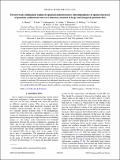Files in this item
Toward weak confinement regime in epitaxial nanostructures : interdependence of spatial character of quantum confinement and wave function extension in large and elongated quantum dots
Item metadata
| dc.contributor.author | Musial, A. | |
| dc.contributor.author | Gold, P. | |
| dc.contributor.author | Andrzejewski, J. | |
| dc.contributor.author | Loeffler, A. | |
| dc.contributor.author | Misiewicz, J. | |
| dc.contributor.author | Hoefling, S. | |
| dc.contributor.author | Forchel, A. | |
| dc.contributor.author | Kamp, M. | |
| dc.contributor.author | Sek, G. | |
| dc.contributor.author | Reitzenstein, S. | |
| dc.date.accessioned | 2014-12-03T12:31:06Z | |
| dc.date.available | 2014-12-03T12:31:06Z | |
| dc.date.issued | 2014-07-31 | |
| dc.identifier | 151372403 | |
| dc.identifier | b9f5f869-a1f3-4f0a-a05b-e1a671154aec | |
| dc.identifier | 000341235500009 | |
| dc.identifier | 84905484405 | |
| dc.identifier | 000341235500009 | |
| dc.identifier.citation | Musial , A , Gold , P , Andrzejewski , J , Loeffler , A , Misiewicz , J , Hoefling , S , Forchel , A , Kamp , M , Sek , G & Reitzenstein , S 2014 , ' Toward weak confinement regime in epitaxial nanostructures : interdependence of spatial character of quantum confinement and wave function extension in large and elongated quantum dots ' , Physical Review. B, Condensed matter and materials physics , vol. 90 , no. 4 , 045430 . https://doi.org/10.1103/PhysRevB.90.045430 | en |
| dc.identifier.issn | 1098-0121 | |
| dc.identifier.uri | https://hdl.handle.net/10023/5861 | |
| dc.description.abstract | In this paper we present a comprehensive and detailed analysis of carrier/exciton wave function extension in large low-strain In0.3Ga0.7As quantum dots (QDs). They exhibit rather shallow confinement potential with electron/hole localization energy below 30 meV and confinement strength substantially weakened in comparison to typical epitaxial quasi-zero-dimensional semiconductor nanostructures. The aim of this study is to investigate the influence of different factors on the wave function (probability density distribution) for carriers or excitons in this regime, i.e., object shape anisotropy as well as strain, piezoelectricity, and Coulomb interactions, and to identify the physical mechanisms determining the properties of optical emission. To probe the wave function symmetry, polarization-resolved photoluminescence has been performed, and the spatial extensions of the corresponding probability densities have been verified in magneto-optical measurements. The observed diamagnetic coefficients in the range of (15-31) mu eV/T2 reflect large in-plane QD size. These studies also enable us to investigate the importance of light hole states admixture to the valence band ground state in such nanostructures, which can be addressed via the degree of linear polarization of emission as well as the exciton gX factor. The linear-polarization-resolved measurements revealed an exceptionally low exciton fine structure splitting of 5 mu eV on average as well as a low emission polarization degree of -0.05, with the polarization perpendicular to the QD elongation direction dominating. The increased light hole contribution to the lowest energy hole level is reflected in the decreased exciton gX factor (in the range of 0-1) and is consistent with the results of the eight-band k.p modelling. Based on the temperature dependence of the diamagnetic coefficient, the problem of individual QD uniformity has additionally been discussed. To evaluate the impact of the confinment potential and the structure geometry on the optical properties of the QDs, a comparison between the investigated dots and InAs/InGaAlAs/InP quantum dashes exhibiting a much deeper confining potential is presented. | |
| dc.format.extent | 10 | |
| dc.format.extent | 740852 | |
| dc.language.iso | eng | |
| dc.relation.ispartof | Physical Review. B, Condensed matter and materials physics | en |
| dc.subject | Optical nonlinearity | en |
| dc.subject | Coulomb interactions | en |
| dc.subject | Dash structures | en |
| dc.subject | Excited-states | en |
| dc.subject | Wetting layer | en |
| dc.subject | Simple-model | en |
| dc.subject | Strain | en |
| dc.subject | Communication | en |
| dc.subject | Electron | en |
| dc.subject | Arrays | en |
| dc.subject | QC Physics | en |
| dc.subject.lcc | QC | en |
| dc.title | Toward weak confinement regime in epitaxial nanostructures : interdependence of spatial character of quantum confinement and wave function extension in large and elongated quantum dots | en |
| dc.type | Journal article | en |
| dc.contributor.institution | University of St Andrews. School of Physics and Astronomy | en |
| dc.contributor.institution | University of St Andrews. Condensed Matter Physics | en |
| dc.identifier.doi | 10.1103/PhysRevB.90.045430 | |
| dc.description.status | Peer reviewed | en |
This item appears in the following Collection(s)
Items in the St Andrews Research Repository are protected by copyright, with all rights reserved, unless otherwise indicated.

